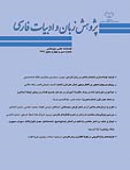بررسي "نامه پولوس رسول به کاتبان" (مرامنامهای از جلال آل احمد)
محورهای موضوعی : Research in Iranian classical literature
1 - دانشگاه قم
کلید واژه: جلال آل احمد رسالة پولوس رسول به كاتبان مجموعه داستان زن زيادي انجيل بارنابا,
چکیده مقاله :
برخي موقعيتهاي اجتماعي- سياسي موجب ميشود كه نويسندگان گاه از شيوهاي غيرمستقيم براي بيان انديشههاي خود استفاده كنند و سخن خود را از زبان شخصيتي ديگر، در زمان و مكاني ديگر مطرح سازند. از جمله اين نويسندگان جلال آلاحمد است كه هنگام چاپ دوم مجموعه داستان «زن زيادي» مطلبي را در آغاز كتاب و به عنوان مقدمه گنجانيده كه نام «رسالة پولوس رسول به كاتبان» بر آن نهاده شده است. اين رسالة برساختة جلال در واقع اعتراض نامهاي بود از جانب او به پرويز ناتل خانلري كه از جماعت روشنفكران مخالف رژيم پهلوي جدا شده و به جمع درباريان پيوسته بود. ضرورت بیان این مسئله آنگاه آشکارتر میشود که بدانیم اين ترفند و شگرد ادبي جلال، به عنوان متنی واقعی از انجیل، به باور بسياري از اهل فرهنگ درآمده، در نوشتههای برخی محققان بدان استناد شده و موجب خطاهاي بسياري گشته است. هدف اصلی اين مقاله، بيان زمينهها و پيامدهاي اين اقدام جلال و ارائه دلايل ساختگی بودن اين رساله بوده است تا از اشتباهات احتمالی نسل جوانتر در این خصوص پیشگیری شود. این ادله به شیوه مطالعات درون متنی و برون متنی (با استناد به مفاد متن نامه و نیز اظهار نظر شفاهی معاصران جلال) انجام پذیرفته است.
Certain social–political conditions may lead the writers to use indirect ways to express their thoughts, for example, reporting them as the words of others in a different time and place. This is what happened for Jalal Al Ahamad, in a preface, titled as the “Letter by Saint Paul to the Writers”, to the second edition of “Zan-e Ziadi” (unwanted woman), a collection of his short stories. The letter is something made by Jalal himself not as seemingly claimed by Saint Paul. It was in fact an expression of objection to Parviz Natel Khanlari who had joined the palace folks, detaching himself from the circle of the intellectuals oppositions to Pahlavi regime. This study becomes of special necessity when we see that this letter has been treated as a true text, not as a poetic technique by Jala, as many researchers did in their references to it in their works. The purpose of the present article is to explore the motives behind inventing this letter, its consequences, and to argue why it is fake, so that we can stop the young generation getting mislead in this regard. The argumentation is done based on the text itself, and the comments by Jalal’s contemporaries, i.e. intra-textual an extra- textual studies.


